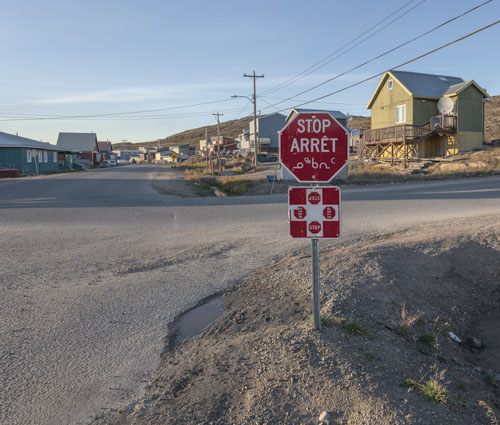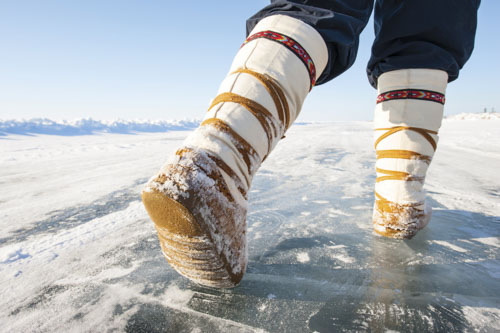Inuktitut language text that explains what a sled is and what it is used for.
Written by Lauren-Rose Stunell
Do you remember growing up and loving the perfect snowman building snow? Inuktut has a word for that! But most people know little about this language group, and have even fallen for a few misconceptions about it.
Inuktitut or Inuktut?
If you were asked “What is the name of the Indigenous language spoken by the Inuit Peoples?” you might commonly think “Inuktitut.” However, Inuktitut is actually just one of several language varieties spoken by Inuit peoples in a dialect continuum that spans from Alaska through Arctic Canada to Greenland. Much like many of the other Indigenous languages featured in this Discovering Languages series, these currently endangered language varieties hold a rich tradition and culture.
For example, Inuinnaqtun is spoken primarily in the western regions of Nunavut and in parts of the Northwest Territories. Inuktitut refers to the language spoken mainly on Baffin Island and region. Both Inuinnaqtun and Inuktitut are official languages of Nunavut, along with English and French. Nunavimmiutut is the dialect spoken in Nunavik (Arctic Quebec), and Inuttitut is spoken in Nunatsiavut (Northern Labrador). While each dialect is unique to a particular region and group of speakers, the closer together two dialects are geographically, the easier it is for their speakers to understand one another.

So what do you call these dialects if you want to refer to them as a whole? In 2015, Inuit Uqausinginnik Taiguusiliuqtiit, a Nunavut-based organization dedicated to protecting and promoting Inuit language, officially adopted “Inuktut” to refer to all Inuit languages. The term means simply “Inuit languages.” While some speakers do not agree with this decision, the term “Inuktut” is now common in Nunavut government documents.

How Many Words for “Snow”?
Another common misconception about Inuktut is that there are over 50 words for snow! While these dialects certainly have rich vocabularies, linguists and anthropologists have criticized this belief. A 1985 dictionary of the Nunavimmiutut (Nunavik) dialect has about a dozen words to describe snow and snowy conditions. While this is a lot less than 50, these words don’t lack detail. Here are six of them:
- Qannik (ᖃᓐᓂᒃ) is the general word for snow as it falls from the sky (snowflakes).
- Aput (ᐊᐳᑦ) describes snow that encompasses the land as part of the environment.
- Apiq (ᐊᐱᖅ) describes the snow on the ground used for building shelters and making blocks for igloos.
- Pukak (ᐳᑲᒃ) is the word used for the very fine, fluffy snow used to fill gaps or insulate an igloo.
- Natiruvaaq (ᓇᑎᕈᕚᖅ) refers to the wet, sticky snow perfect for snowballs or building a snowman.
- Maujaq (ᒪᐅᔭᒡ) refers to the icy crust over the fluffy snow underneath — the type of snow into which our foot sinks when we walk without snowshoes.
These words give us a glimpse into the deep connections between Inuit languages, Inuit culture, and the land. Even though “50+ words for snow” is a misconception, each of these words holds specific, significant meanings that highlight the major impacts that snow and winter conditions have traditionally had on life in these regions.
Exploring Inuktut Through Discussion and Art
Lesson Description
At the end of this lesson, learners will be able to appreciate the rich tapestry of history, culture, and traditions woven by the Inuit Peoples into their languages. They will be able to recognize and represent different terms for “snow” in the Nunavimmiutut (Nunavik/Arctic Quebec) dialect and begin to greet and welcome others in the Inuttitut (Nunatsiavut/Northern Labrador) dialect. Students will use the target language to discuss the terms and create visual representations of their new vocabulary. This lesson is directed towards lower and upper elementary students; however, it can also be adapted for students of all ages from elementary to post-secondary. After all, learning a new language, especially an Indigenous one, is for everyone!
Content
- In the target language, lead a class discussion about Inuktut and Inuit Peoples and introduce the concept of dialects. Use this “Welcome to Nunavut” video from Nunavut Tourism to jumpstart the discussion. Here are some sample discussion questions:
- What do students notice in the video?
- What do they already know about Nunavut and other places where Inuit live?
- What do students think about the way in which Inuit have adapted to survive and thrive in this climate?
- Do they have any personal experience with dialects?
- Students can work with their teacher’s guidance to listen to some phrases in Inuttitut on SoundCloud.
- Use this blog post to teach students some different terms for snow (in the Nunavimmiutut dialect). Students can describe the type of snow in their own words in the target language and create authentic connections to their own experience if they also live in a snowy region of Canada.
- Have each student choose a type of snow that they would like to represent. Students will create an art piece with that type of snow as the central theme. For instance, they may choose to create a snowman to display natiruvaaq or a painting that showcases their understanding of qannik.
- Students can finish their art piece by creating an artist statement in the target language to describe the word they chose and the way in which the word might hold connection and meaning for Inuit Peoples and their respect for the land. They can also highlight the word and what it means to them to have connection to the Indigenous land in which they reside and the importance of preserving these languages, cultures, and traditions.
Lesson Conclusion
To conclude this lesson, students could create an art show or a gallery walk of their artwork to honour and recognize the contributions of Indigenous Peoples and highlight the unique Inuktut languages in their school or educational institute.
Extending the Activity for Younger and Older Students
To extend this activity for younger students, The Inuit Thought of It: Amazing Arctic Innovations is a very useful book by Alootook Ipellie and David MacDonald. Students may be surprised to learn that the Inuit invented many things, from kayaks to snow goggles. Since Ipellie was also an artist (inducted into Canadian Cartoonist Hall of Fame!), you can also extend the activity by looking at his art and that of other Inuit artists.
To extend this activity for older students, educators could start a class discussion about the importance of preserving languages and the meaning of a language to one’s culture and identity. Educators working at the secondary or university level could ask students to research the importance of preserving Inuktut languages and create posters to bring awareness and curiosity to their school community on understanding the need to respect, honour, and preserve Indigenous languages.




